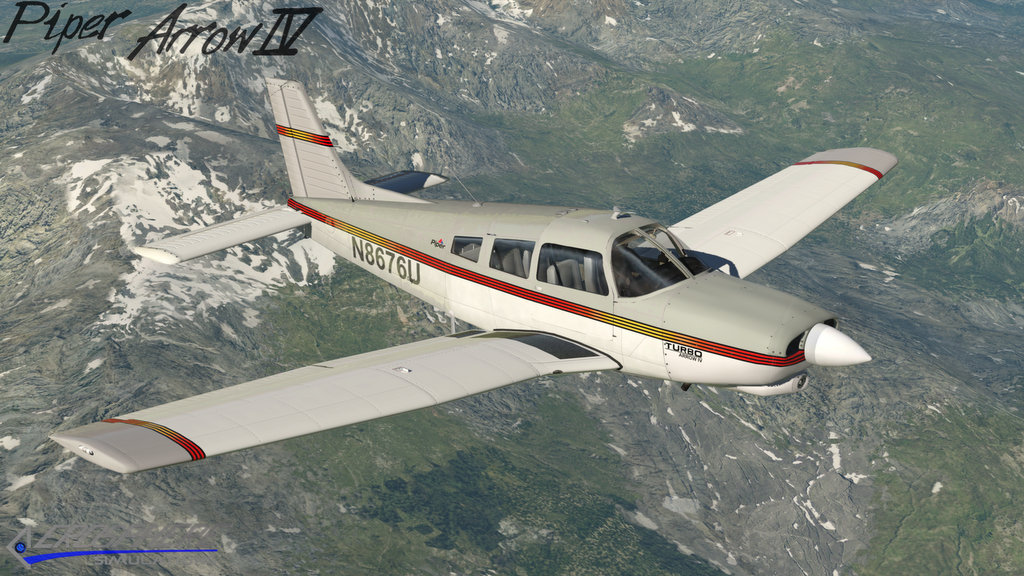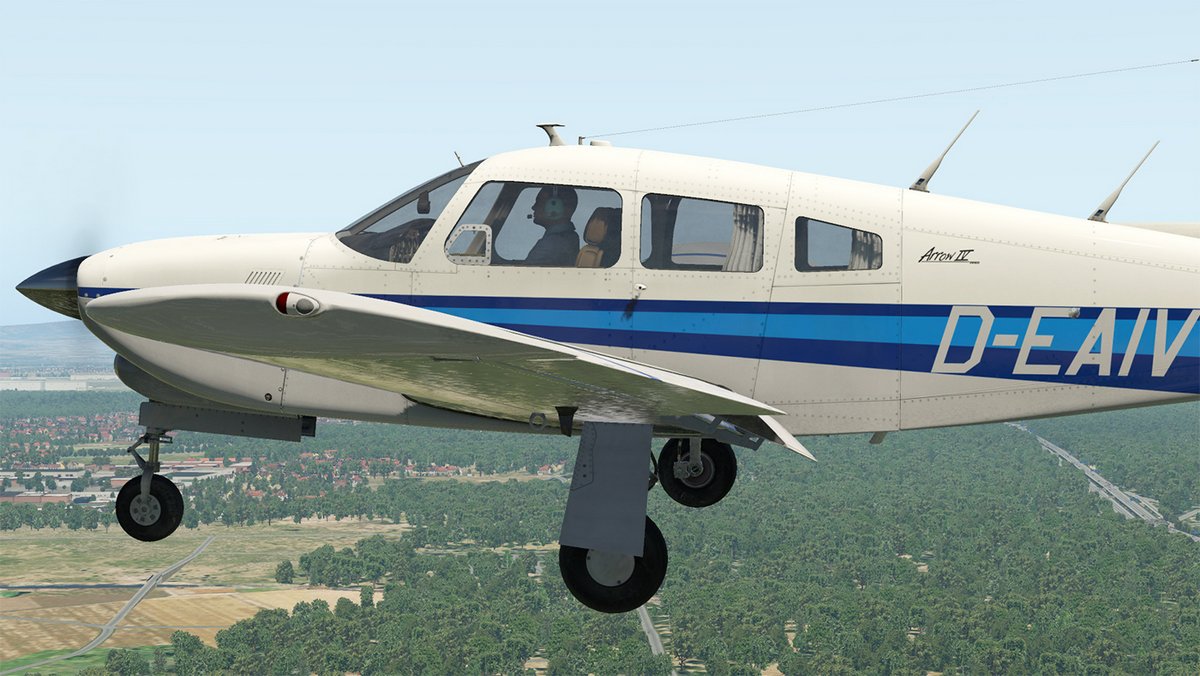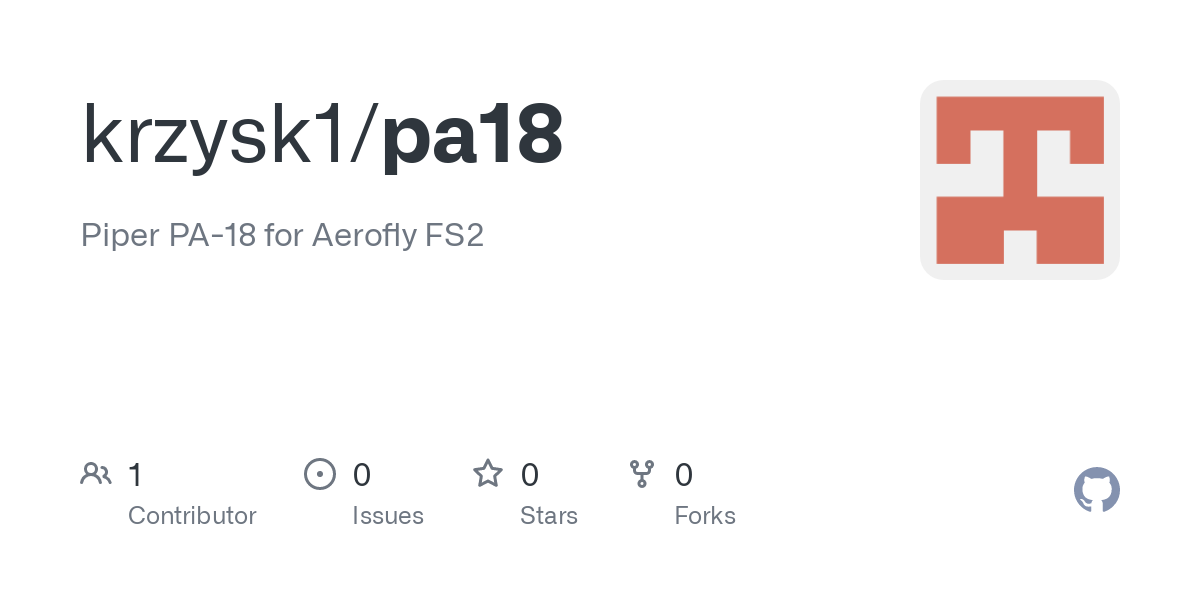aenbacka Just to clarify things, is the Carbon Cub project something that is intended to be released as a commercial payware product?
Posts by jayeye2011
-
-
What documentation are you referring to? If its this https://www.aerofly.com/dokuwiki/doku.…craft:modelling then as far as I know everything on the aerofly wiki is for Aerofly FS2 and it has not been updated for FS 4. Jet-Pack (IPACS) would have to answer the plugin question, maybe IPACS has up-to-date 3ds Max, Maya, AC3D plugins in house that they would provide on request (most likely not unless they use that CAD program for in-house product).
-
If you get error messages and want someone (like Jet-Pack) to help you, you should post a zip of the error messages files so they have something to work with.
-
You should check with Jet-Pack (IPACS) but my impression is that IPACS is only updating the Blender plugin going forwards, it's certainly the only one that they make available publicly on their developers website. Also maybe I am wrong, but I was looking into Aerofly FS's method of animating moving parts which I originally thought was done via their plugin in the 3D CAD program assuming it to be like hoow X-Plane's Blender plugin works. But it turns out that the X-Plane OBJ8 format which is generated by the it's plugin contains both the vertices data and the animation data. X-Plane's plugin does not use the native key frame animation system of Blender, it provides its one interface for this in the plugin. However, the Aerofly FS 4 blender plugin is just a straight vertices converter. My current understanding is that the aircraft tmd file is where you must manually write in the parts animation code that is tied to a specific graphic object is defined in the tgi file, so the 3D CAD program's native animation system is not used at all.
Some Examples from Kaniewski's Cub Special tmd file:
Code
Display More<[rotatingbodygraphics][Spinner][] <[uint32][PositionID][Fuselage.R]> <[uint32][OrientationID][Fuselage.Q]> <[string8][GeometryList][ Spinner ]> <[uint32][AngleID][Propeller.RotationAngle]> <[tmvector3d][Axis][ 1.0 0.0 0.0 ]> <[tmvector3d][Pivot][ 1.718 -0.0058 -0.3018 ]> > <[hingedbodygraphics][LeftElevator][] <[uint32][PositionID][HorizontalStabilizer.R]> <[uint32][OrientationID][HorizontalStabilizer.Q]> <[string8][GeometryList][ LeftElevator ]> <[uint32][InputID][Elevator.Output]> <[tmvector3d][Axis][ 0.0 -1.0 0.0 ]> <[tmvector3d][Pivot][ -4.4849 -1.5959 -0.0113 ]> > <[hingedbodygraphics][AirspeedIndicator][] <[uint32][PositionID][Fuselage.R]> <[uint32][OrientationID][Fuselage.Q]> <[string8][GeometryList][ AirspeedNeedle ]> <[tmvector3d][Axis][ 0.9947 0.0 -0.1028 ]> <[tmvector3d][Pivot][ 0.6099 0.1089 -0.1362 ]> <[string8][InputID][AirspeedIndicatorNeedle.Output]> > <[hingedbodygraphics][RPM][] <[uint32][PositionID][Fuselage.R]> <[uint32][OrientationID][Fuselage.Q]> <[string8][GeometryList][ RpmNeedle ]> <[string8][InputID][RotationSpeedNeedle.Output]> <[tmvector3d][Axis][ -0.9941 0.0 0.1083 ]> <[tmvector3d][Pivot][ 0.6127 0.2223 -0.1366 ]> > -
Here are two more aircraft that would be interesting sightseeing planes as Aerofly FS 4 models:
Seeker Aircraft Seabird Seeker
source: https://www.seekeraircraft.com/gallery.html
Paramount Group Mwari
source: https://www.paramountgroup.com/capabilities/air/mwari
-
Isn't Autodesk Maya like a $5000/seat commercial software like 3DS Max? Man, I would just stick to using Blender unless you are thinking to become a payware aircraft model developer but I doubt you would make your investment back in sales. I too would be interested in hearing what @Jet-Pack has to say about this. I know at one time long ago both Laminar Research and IPACS used to have converter plugins for other 3D CAD programs but I think they eventually switched over to only supporting Blender. I am guessing because it is free and very full featured (actually more than you need probably for just flight simulator models), and in the case of X-Plane encourages hobbyists to try making their own airplanes for their favorite flight simulator. That was a very smart move on Laminar Research's part. That and having a GUI based aircraft file editor called Plane Maker is why X-Plane 11 has literally hundreds of freeware aircraft available for it including helicopters. In fact, from what I have read in the forums, if you just want to test out an idea for your own custom aircraft design, you don't even need a 3D CAD program with Plane Maker because it can create a very basic 3D aircraft shape which you can then fly in the X-Plane simulator.
-
Jet-Pack (IPACS) What is the copilot.tmc file? Is there any documentation for it explaining what it is needed for, what parameters are needed, and what they are used for?
-
Before takeoff or landing flight testing, I would focus on ground testing - being able to accelerate and slow down on the tarmac, being able to turn left and right on the tarmac, being able to brake to a stop. Currently, the only way to know your engine is running and under positive control is being able to speed up and slow down in response to throttle position. If you had an RPM instrument or engine sound setup then would also help. At the same time I would suggest getting your tailwheel, ailerons, flaps, elevator, and rudder graphics tied into the tmd file and tested on the ground before flying (both for correct deflection limits and direction sense and response speed). Regardless of the real world aircraft free castering or not steering system, please always implement either nosewheel or tailwheel steering since a lot of FS 4 users are not going to have differential braking rudder pedals controls. I would get the engine sound connected and create the RPM instrument frame animation setup in you cockpit panel as engine RPM is not available in the flight information bar display. Throttle position does not really correlate well to engine RPM like 50% throttle is not going to give you 50% of the max RPM.
-
It also may be that you have not defined all the tmd:engine2 parameters correctly so that maybe your engine is running but you cannot actually control it yet?
I suggest experimenting with Kaniewski's Club Special engine2 settings to see which parameters must be defined to have control of the engine rpm.
-
Also, from what I can understand from glancing athe aircraft:tmd:instruments wiki airspeed indicator discussion
aircraft:tmd:instruments [Aerofly FS Wiki]
"The output is differentiated to get the airspeed trend and the airspeed and the airspeed trend are then send to external devices or the flight info bar via sender objects."
So if you include a sender for the throttle you should see your throttle position on the "I" key flight info bar, to see if you throttle command is changing.
-
There are also developer cameras CTRL+F7 CTRL+F8 ?? if debug enabled in main.cfg
sdk:developer_camera [Aerofly FS Wiki]
External Content www.youtube.comContent embedded from external sources will not be displayed without your consent.Through the activation of external content, you agree that personal data may be transferred to third party platforms. We have provided more information on this in our privacy policy. -
Also, I would ask Jet-Pack about what information can be on-screen display enabled during flight for developer debugging. There are some settings in the main.cfg that might allow you to specify what data you want to see via the Ctrl+F1 and Ctrl+F2 developer debug display commands. For instance, it would be very good to see engine rpm so you could tell if the engine was still running after the crash.
Code
Display MoreDeveloper debug related settings at the very bottom of the main.cfg file <[bool][debug_show_log][false]> <[bool][debug_show_fps][false]> <[settings_developer][developer_settings][] <[bool][Enabled][true]> <[string8][DeepDeveloperMode][]> <[string8][SpecialDeveloperMode][]> <[float64][TimeLapse][1]> <[float64][IntegrationDeltaTime][0.001]> <[bool][ShowMonitoring][false]> <[vector4_float32][MonitoringPosition][0.0020000000949949 0.0020000000949949 0.400000005960464 0.300000011920929]> <[bool][PauseInDebugView][true]> > -
Suggest using the replay function (available when you pause) and moving the camera around to see if something other than the wheels contacted the ground. You could also change the "restart time after crash" under Miscellaneous settings so it takes longer or does not happen at all so you can inspect the aircraft after the crash. If the propeller hits the ground I thought it would fragment off or at least stop not be spinning? The -120FPM descent rate seemed low enough at touchdown that it should not have caused a crash event to be reported. I assume the gear was drop tested via setting the initial start position in the tmc file so you know your main and tail landing gear Kp and Kd values don't cause a reset. The 3D model is only a facade while the simulation engine is really using the tmd parameters for actual physics calculations including where parts contact spheres intersect with terrain, so just because the 3D model does not show contact does not mean the TMD model did not contact the ground. I don't know but maybe the tm.log might report something?
-
you can do it also... start conversation to him, did he answer ?
I posted a comment requesting an FS4 version on the Dornier 27 page on flight-sim.org Jan 2, 2022 but he never replied, so I figured he was no longer active. I just thought since all users have provide their contact email to you for registration you had a way to contact him via email. Well, it's a shame but I am not willing to try to recreate the Do 27 from scratch either so I have no right to complain either.
-
Jan, hast Du ne mailadresse von dem ?
Higgy, since you operate the flight-sim.org web site, can't you contact the guy who did the Do-27 and see if he would be willing to do an update or maybe talk to Jet-Pack about doing a conversion?
Dornier 27 / CASA 127 - Flight-Sim.orgDornier do27 / Construcciones Aeronáuticas SA 127 To install just unzip the file in your Aerofly fs2 aircraft directory Please keep in mind that Im not a…flight-sim.org -
I don't have the original files for the Do27, so I can't convert it.
Thanks, it is good to know but I am kind of sad at the same time.
-
If the aircraft type is more important than the scenery, there are multiple PA-28R III/IVs for X-Plane 11 with full functionality unlike the Aerofly FS 2 Just Flight versions.
 Piper Turbo Arrow IV-AeroSphere-PA28RT-201Tstore.x-plane.org
Piper Turbo Arrow IV-AeroSphere-PA28RT-201Tstore.x-plane.org PA-28R TURBO ARROW III / IV-JustFlight-PA28Tstore.x-plane.org
PA-28R TURBO ARROW III / IV-JustFlight-PA28Tstore.x-plane.orgJust to repeat what was said before, the Aerofly FS2 Just Flight aircraft cannot be converted to work in FS 4. The original raw sound (.wav), texture (.png), and intermediate graphics (TGI) or 3DS Max model files files would be required which is Just Flight copywrite proprietary intellectual property which would have to be reverse engineered/hacked illegally from the Aerofly FS 2 versions you bought.
-
Isn`s it easyier to ask the authors directly ...?
What did they say ?I have no idea how to contact Mr Munoz. As for Jan-Hendrik Hanuschik (who I assume is Jet-Pack on this forum) I did post the question on his aerofly.de website but never got a response. I would just like to satisfy my curiosity about this really nice (except for the paint job) model. But I suspect that Mr. Munoz is the one that had all the raw file assets required for the conversion but has since dropped out of the Aerofly FS community. I hope he is well and just lost interest or maybe switched to another flight sim rather than got caught by the Covid19 pandemic.
-
Kaniewski also had a PA-18 Super Cub model for FS 2 which had a different tmd file configuration. Might be worth looking at although it was never converted to FS 4. The PA-18 would be a closer match for a Carbon Cub than the PA-11 since it had flaps and the PA-11 does not, more powerful engine, and looks to be a different airfoil setup in the tmd file which is questionable since they both are supposed to use the USA 35B airfoil. However Kaniewski's PA-18 seems to have used a fixed pitch propeller whereas I would assume the Carbon Cub being more modern setup might use a constant speed propeller setup?
 GitHub - krzysk1/pa18: Piper PA-18 for Aerofly FS2Piper PA-18 for Aerofly FS2. Contribute to krzysk1/pa18 development by creating an account on GitHub.github.com
GitHub - krzysk1/pa18: Piper PA-18 for Aerofly FS2Piper PA-18 for Aerofly FS2. Contribute to krzysk1/pa18 development by creating an account on GitHub.github.comHere is a sometimes useful listing of aircraft vs airfoil used
-
Strange, I wonder if a good Kp value depends on aircraft weight, seems to vary a whole lot.
Examples:
C172
<[multibody_joint][JointFuselageRightGear][]
<[string8][Body0][Fuselage]>
<[string8][Body1][RightGear]>
<[tmvector3d][R0][ 0.1 -0.5 -0.5 ]>
<[tmvector3d][X0][ 1.0 0.0 0.0 ]>
<[float64][Kp][70000.0]>
<[float64][Kd][1500.0]>
<[uint32][Type][0]>
>
Jungmeister
<[multibody_joint][JointFuselageRightGear][]
<[string8][Body0][Fuselage]>
<[string8][Body1][RightGear]>
<[tmvector3d][X0][0.930765 0.000004 0.365618]>
<[tmvector3d][R0][0.442420 -0.025636 -0.927850]>
<[float64][Kp][20000.0]>
<[float64][Kd][2000.0]>
<[uint32][Type][0]>
<[string8][InputPosition][0.1]>
>
DR400
<[multibody_joint][JointFuselageFrontGearUpper][]
<[string8][Body0][Fuselage]>
<[string8][Body1][FrontGearUpper]>
<[tmvector3d][X0][-0.1276 0.0 0.9918]>
<[tmvector3d][R0][1.25972 -0.07824 0.03]>
<[float64][Kp][50000.0]>
<[float64][Kd][1000.0]>
<[uint32][Type][0]>
<[string8][InputPosition][ServoSteering.Output]>
>
F4U
<[multibody_joint][JointRightGear2RightGear3][]
<[string8][Body0][RightGear2]>
<[string8][Body1][RightGear3]>
<[tmvector3d][X0][0.000000 0.000000 1.000000]>
<[tmvector3d][R0][ 1.8290 -1.6403 -1.5134 ]>
<[float64][Kp][100000.0]>
<[float64][Kd][50000.0]>
<[uint32][Type][1]>
>
Camel
<[multibody_joint][JointFuselageRightGear][]
<[string8][Body0][Fuselage]>
<[string8][Body1][RightGear]>
<[tmvector3d][X0][1.0 0.0 0.0]>
<[tmvector3d][R0][ 0.17619 -0.3 -0.572081 ]>
<[float64][Kp][200000.0]>
<[float64][Kd][800.0]>
<[uint32][Type][0]>
>
